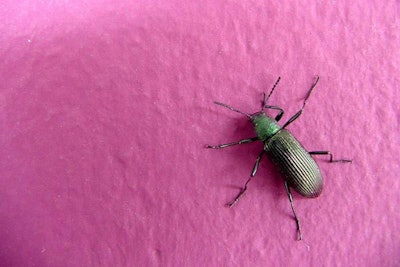
Reducing the occurrence of darkling beetles and pests is imperative for poultry production to be profitable. Despite industry advances, insect control is not a simple matter and takes a dedicated effort on the producer’s part to be successful.
While it’s difficult to predict poultry pest pressures for 2016, producers can get in front of issues by preparing for pest problems before they become an issue — focusing on the challenges faced, type of insecticides needed and rotation efforts.
Controlling darkling beetles
In the broiler industry, the most important aspect of insect control is controlling darkling beetles. They can cause significant damage and be a nuisance to poultry operations through disease transmission, structural damage and even invasion of neighboring buildings. These insects are persistent in poultry houses and can act as carriers of zoonotic bacteria, such as Salmonella and Campylobacter, and viruses such as corona virus.

Darkling beetles and their larvae can survive in empty broiler houses between rearing cycles and may cause damage to the building’s infrastructure by eating their way into insulation material in ceilings and walls. | Courtesy of Bayer
The destruction of insulation materials causes a loss in the R-value (measure of the resistance of a material to conduct heat as indicated by the difference between inside and outside surface temperatures) of the building and a decrease in the “tunnel effect” as the house becomes more leaky. This drives up the amount of run time the fans have to maintain a constant static pressure to keep air speed up especially in the summer. As a result, there is loss both in the summer (leaky houses with increase electric bills) and winter (loss of R-value with increase in propane costs).
In addition, when litter is taken out of the houses, the beetles may spread.
Defending your operation
When it comes to helping control beetle populations, create an effective pest control strategy that covers your entire operation as well as other pests that may be of concern — including flies, spiders and mites. Two fundamental actions you can take to control infestations are to practice good sanitation and to use appropriate chemical control.
Producers should divide their pest control efforts into two key areas — the facility and environment:
- Facility. Where poultry eat, sleep and lay eggs are prime locations for pests and the diseases they can pass from one animal to another. Treating litter, cages and flooring of the broiler and/or egg-laying operation can aid in stopping the spread of pests.
- Environment. Pests may use the areas beyond the immediate housing facilities to breed and replenish their numbers. Treating these areas can play a significant role in reducing the pest population.
Focusing on protecting the facility and environment can help minimize issues from these pests, while on-animal sprays and dusts also can help protect birds from mites.
Using documentation, sensitivity training and science
Proper documentation of the beetle population is equally important. Producers should consider using a scoring system to document the level of beetle population in each flock. Monitor changes in the beetle population weekly and get a clear idea of the infestation levels. Use a color coded chart that will allow you to determine when an intervention may be needed.
Proper documentation of the beetle population is equally important.
Producers should also look at testing for beetle sensitivity and susceptibility. This gives producers an idea of the insect’s tendency to be killed by an insecticide. The more susceptible the beetles are to an insecticide, the more efficiently it works against them. The test will use insecticides belonging to different classes based on mode of action (MOA), and the results will tell you to which class of insecticides the darkling beetles are most susceptible. This helps producers determine an appropriate rotation strategy.
Rotating active ingredients to maintain effectiveness
The development of resistance to insecticides due to the repeated use of compounds belonging to the same MOA is another concern for producers. Proper documentation of the products used in between each flock in each poultry house is needed for insecticide resistance management. Producers who have proper documentation and a rotation of insecticides will have a lesser chance of seeing severe problems.
Producers who have proper documentation and a rotation of insecticides will have a lesser chance of seeing severe problems.
An effective rotation strategy alternates between products from completely different MOA groups, not just between active ingredients from the same MOA group. Modes of action available include:
- Pyrethroids: sodium channel modulators that disrupt the normal flow of sodium ions
- Organophosphates: cholinesterase inhibitors that prevent the breakdown of acetylcholine
- Neonicotinoids: acetylcholine receptor agonists that mimic the action of acetylcholine
Keeping flocks healthy
At the end of the day, reducing beetle populations that spread disease not only means a cleaner operation, but also potentially a healthier flock. A study on the economic impact of darkling beetles determined that a good beetle control program can save producers as much as US$4,262 per 100,000 birds.















